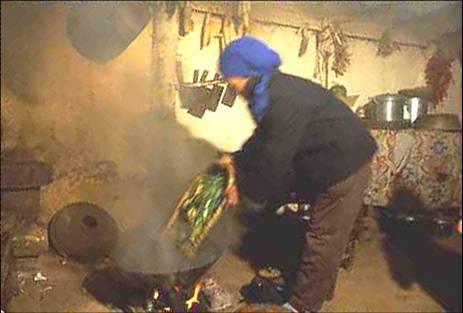About half of the world’s population is exposed to smoke from heating or cooking with solid fuels. Household air pollution (HAP) from solid fuel use was estimated to cause 4.3 million deaths in 2012 (7.7 percent of global mortality). To study the role of indoor air pollution from solid fuel use in lung cancer risk, particularly among never-smoking women, DCEG investigators from the Occupational and Environmental Epidemiology Branch conducted a series of investigations in Xuanwei County, China, where lung cancer rates among never-smoking women are among the highest in the world. A retrospective cohort study found that use of smoky coal relative to smokeless coal was associated with a 99-fold increase in lung cancer risk among women, almost all of whom were never-smokers. This represents one of the strongest effects of an environmental exposure reported for cancer risk in any population to date. To identify which components of coal combustion account for the striking increase in lung cancer risk in Xuanwei, and to characterize other important exposures, a new case-control study of never-smoking female lung cancer that includes an extensive exposure assessment component has been conducted to identify the components of coal combustion products that drive lung cancer risk in this population and the genetic variants that modify effects. New findings show that we can explain a substantial amount of the high lung cancer risk in this population based on exposure to a subgroup of compounds we have measured.
To expand the study of the environmental and genetic etiology of lung cancer among never-smoking women, we formed the Female Lung Cancer Consortium in Asia and conducted the first large-scale genome-wide association study (GWAS) of lung cancer among never-smoking females anywhere in the world. This study recently identified novel loci that have not been linked to lung cancer among smokers in either Asia or the West, and found evidence for gene-environment interactions with coal use for home cooking and heating. We are in the process of expanding the GWAS and also conducting whole genome sequencing of tumor samples from a subgroup of cases in the study.
References
Shi J, Shiraishi K, Choi J...Lan Q. Genome-wide association study of lung adenocarcinoma in East Asia and comparison with a European population. Nat Commun 2023.
Blechter B, Wong JYY, Hsiung CA...Lan Q. Sub-multiplicative interaction between polygenic risk score and household coal use in relation to lung adenocarcinoma among never-smoking women in Asia. Environ Int 2021.
Bassig BA, Dean Hosgood H, Shu XO...Lan Q. Ischaemic heart disease and stroke mortality by specific coal type among non-smoking women with substantial indoor air pollution exposure in China. Int J Epidemiol 2020.
Vermeulen R, Downward GS, Zhang J, Hu W...Lan Q. Constituents of Household Air Pollution and Risk of Lung Cancer among Never-Smoking Women in Xuanwei and Fuyuan, China. Environ Health Perspect 2019.
Seow WJ, Matsuo K, Hsiung CA...Lan Q. Association between GWAS-identified lung adenocarcinoma susceptibility loci and EGFR mutations in never-smoking Asian women, and comparison with findings from Western populations. Hum Mol Genet 2017.
Lan Q, Hsiung CA, Matsuo K...Rothman N. Genome-wide association analysis identifies new lung cancer susceptibility loci in never-smoking women in Asia. Nat Genet 2012.
Barone-Adesi F, Chapman RS, Silverman DT...Lan Q. Risk of lung cancer associated with domestic use of coal in Xuanwei, China: Retrospective cohort study. BMJ 2012.
For more information, contact Dr. Qing Lan.
Occupational and Environmental Epidemiology Branch - Research Areas
